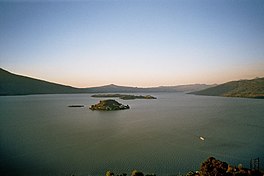Lake Pátzcuaro
| Lake Pátzcuaro | |
|---|---|
| Pátzcuaro Lake | |
| Lago de Pátzcuaro(Spanish) | |
 View fromJanitzio Island | |
| Location | Pátzcuaro,Michoacán |
| Coordinates | 19°36′54″N101°39′00″W/ 19.61500°N 101.65000°W |
| Basincountries | Mexico |
| Islands | Jaracuaro,Uranden,Janitzio,Pacanda,Yunuen,Tecuena |
| Settlements | Pátzcuaro,Erongarícuaro,Quiroga,Tzintzuntzan |
| Official name | Humedales del Lago de Pátzcuaro |
| Designated | 2 February 2005 |
| Reference no. | 1447[1] |
Lake Pátzcuaro(Spanish:Lago de Pátzcuaro) is alakein the municipality ofPátzcuaro,Michoacán,Mexico.
Lake Pátzcuaro lies in anendorheic basin,which does not drain to the sea. A watershed area of 929 square kilometres drains into the lake, of which 126.4 are the water body. The Lake Pátzcuaro watershed extends 50 kilometres east–west and 33 kilometres from north to south. Lake Pátzcuaro lies at an elevation of 1,920 metres, and is the center of the basin and is surrounded by volcanic mountains with very steep slopes. It has an average depth of 5 metres and a maximum of 11. Its volume is approximately 580 million cubic metres.[2]
The Lake Pátzcuaro basin is of volcanic origin. At times it has been part of an open and continuous hydrological system formed byLake Cuitzeo,Pátzcuaro andLake Zirahuén,which drained into theLerma River.Today, like lakes Cuitzeo and Zirahuén, it is a closed basin, although ecologists consider it a sub-basin of the Lerma-Chapala basin.[2]
Wetlands
[edit]The lake is surrounded by extensivewetlands,which have been designated as aRamsar sitesince 2005.[1]Cattailsand other reedy vegetation are the dominant wetland vegetation, in dense stands over 2 meters tall. Typical wetland plant genera includeTypha,Scirpus,Eleocharis,andCyperus.The dominant species of aquatic vegetation arePotamogeton illinoensis,Scirpus pectinatus,Typha latifolia,T. domingensis,andNymphaea mexicana.[3]
The wetlands are extremely important for birds, both year-round inhabitants and migrating waterfowl. Close to 200 species inhabit the wetlands, including some endemic species such as theblack-polled yellowthroat(Geothlypis speciosa). Two native species have not been observed recently; theyellow rail(Coturnicops noveboracensis)has not been seen since 1964 and may be locally extinct, and the endemicslender-billed grackle(Quiscalus palustris) is presumed extinct.
TheLake Pátzcuaro salamander(Ambystoma dumerilii) isendemicto the basin. Among other aquatic or semi-aquatic animals, several are largely or entirely restricted to the Lake Pátzcuaro system, such as therough-footed mud turtleof the subspeciestarascense,[4]the essentially harmlessMexican garter snakeof the subspeciespatzcuaroensis,[5]the fishPátzcuaro chub(Algansea lacustris) andPátzcuaro allotoca(Allotoca diazi),[6]and the dwarf crayfishCambarellus patzcuarensis.[7]
The lake and its surrounding wetlands have undergone significant environmental changes over the past 50 years. Logging and agriculture in the surrounding watershed have contributed to siltation of the lake (1 cm / year - 1.2 million cubic meters / year), and water diversion for agriculture and urbanization has reduced the size of the lake by 40 square kilometers, and 2.6 meters in depth. Other threats include untreated sewage, the introduction of exotic species, and chemical pollution.[8]
In February 2021, members of the Supreme Indigenous Council of Michoacán (CSIM) noted that political opportunism, corruption, and a lack of coordination have undermined efforts to clean up the lake. They noted that since 2006 MXN $5 billion has been spent, and since 1934, 2,300 studies have been conducted, yet 79% of the inhabitants ofPátzcuaro,Erongarícuaro,Quiroga,andTzintzuntzanlive in poverty and 40% inextreme poverty.[9]
Watershed
[edit]In the watershed surrounding the wetlands, the natural terrestrial vegetation is composed of xeric scrub (1,920-2,100 m above sea level), pine and oak forests intertwined with xeric scrub (2,100-2,400 m) and by pure pine-oak forests in the higher peaks (2,400-2,900 m). The pine-oak forests are part of theTrans-Mexican Volcanic Belt pine-oak forestsecoregion.[3]
In the last fifty years, human activity in the watershed has intensified. Farming and livestock ranching in the basin have significantly increased. Over 10,000 hectares of forest have been lost to logging, fires, fuelwood gathering, and clearance for farming and ranching.[8]
History
[edit]The Lake Pátzcuaro basin is home to thePurépecha people.Purépecha leaders established the basin as the heartland of theTarascan state,which rivaled theAztec Empirebefore the Spanish conquest. The towns ofIhuatzio,TzintzuntzanandPátzcuarowere important Purépecha centers.
Islands in the lake
[edit]- Jaracuaro
- Uranden- Small island.
- Janitzio- Island with tourist facilities
- Pacanda- The largest, flattest island. Cabanas for rent.
- Yunuen- Small island
- Tecuena- Sparsely populated island
Major towns along the lake shore
[edit]- Pátzcuaro- Situated on the southeastern shore of Lake Patzcuaro
- Erongarícuaro- Historic Purépecha site
- Quiroga- Thriving market town
- Tzintzuntzan- Market town with ruins nearby - Capital of the P'urhépechas
Minor towns along the lake shore
[edit]- Tocuaro- woodworking and maskmaking
- Opongio- mezcal distillery
- Puacuaro
- Arocutin
- Ihuatzio- ancient temple ruins called yacatas.
- Santa Fe La Laguna- crafts
- Cucuchuchu
- Uricho
- Napizaro
- Erongarícuaro
Nearby areas
[edit]References
[edit]- ^ab"Humedales del Lago de Pátzcuaro".RamsarSites Information Service.Retrieved25 April2018.
- ^ab"Descripción de la cuenca",Recuperación Ambiental del Lago de Pátzcuaro.Accessed October 18, 2009.[1]Archived2009-04-16 at theWayback Machine
- ^ab"Central Mexican wetlands".Terrestrial Ecoregions.World Wildlife Fund.RetrievedOctober 18,2009.
- ^Rhodin, A.G.J.; J.B. Iverson; R. Bour; U. Fritz; A. Georges; H.B. Shaffer; P.P. van Dijk (2017).Turtles of the World: Annotated Checklist and Atlas of Taxonomy, Synonymy, Distribution, and Conservation Status(PDF).Vol. 7 (8 ed.). pp. 1–292.doi:10.3854/crm.7.checklist.atlas.v8.2017.ISBN9781532350269.
{{cite book}}:|journal=ignored (help) - ^Conant, R. (2003)."Observations on garter snakes of the Thamnophis eques complex in the lakes of Mexico's transvolcanic belt, with descriptions of new taxa".American Museum Novitates(3406): 1–64.doi:10.1206/0003-0082(2003)406<0001:OOGSOT>2.0.CO;2.hdl:2246/2832.S2CID86078121.
- ^Ceballos, G.; E.D. Pardo; L.M Estévez; H.E. Pérez, eds. (2016).Los peces dulceacuícolas de México en peligro de extinción.Fondo de Cultura Económic.ISBN978-607-16-4087-1.
- ^Alvarez. F.; J.L. Villalobos (2015). "The Crayfish of Middle America". In T. Kawai; Z. Faulkes; G. Scholtz (eds.).Freshwater Crayfish: A Global Overview.CRC Press. pp. 448–463.ISBN9781466586390.
- ^ab"Indicadores del deterioro ambiental",Recuperación Ambiental del Lago de Pátzcuaro.Accessed October 18, 2009.[2]
- ^Martínez Elorriaga, Ernesto (February 10, 2021)."La Jornada - Fracasan por corrupción planes para salvar el lago de Pátzcuaro".jornada.com.mx(in Spanish). La Jornada.RetrievedFebruary 10,2021.

